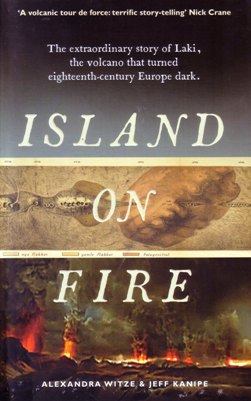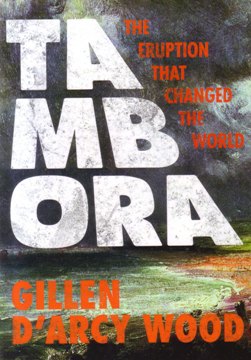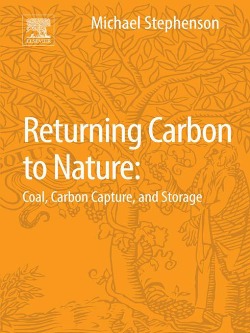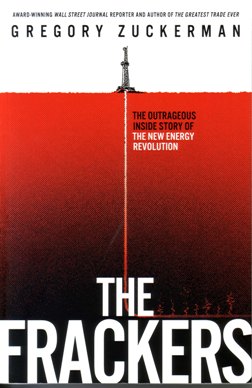 Island on Fire
Island on Fire
In 1783 a section of south west Iceland split open. Huge volumes of lava and ash spewed out along a wall of fire - the Laki Fissure Eruption. It lasted into 1783, causing famine and death in Iceland and beyond. Crops failed all over northern Europe and its climatic repercussions may even have helped precipitate the French Revolution. Similar eruptions are bound to occur again. How would we cope? This is the question this book’s two science-writer authors set out to examine. The answer is not cheerful.
Ask a member of the public to name any historic eruption, and you will get ‘Krakatoa’ and for another year or two, one with the already forgotten name that stopped flights in 2010 - Eyjafjallajökull, news peg for this book. However it is one of the authors’ more surprising assertions that Laki is ‘forgotten’. Actually, commented on by great contemporaries, documented in detail by local eyewitness Jòn Steingrímsson, perpetuated in Earth science curricula, rarely omitted from popular volcanology books, Laki is a lot less forgotten than most.
The book reads like a set of excellent lecture notes, detail omitted for the sake of brevity (and to give students something to look up in the library). Difficult science is rather glossed over. Areas of controversy (most interesting to the general public) are sadly ignored while history comes perilously close to the ‘cardboard’ that Steven Jay Gould so abominated. Scholarly accounts are name-checked throughout and well referenced, which will please students and academics.
What of human interest? The story of Laki hardly lacks harrowing tales - death by starvation, asphyxia, fluorosis - described by Pastor Steingrímsson (the miracle worker whose ‘fire mass’ apparently halted the lava, and to science, Laki’s great chronicler). His career is perhaps even more compelling raw material for a writer than Iceland’s volcanoes; but it is recounted here in surprisingly neutral tones, crammed into a short chapter. The ‘completist’ urge to mention everything has won out over creative storytelling. Once again, students may be grateful for this.
Island on Fire is an excellent undergraduate reader, and its notes and further reading lists will recommend it to an academic audience, who also will welcome the way it broadens to look at global volcanic eruptions generally. However while lay readers will end it better informed, they may, as I was, be a little surprised that they were not better entertained.
Reviewed by Ted Nield
ISLAND ON FIRE – THE EXTRAORDINARY STORY OF LAKI, THE VOLCANO THAT TURNED EIGHTEENTH-CENTURY EUROPE DARK.
ALEXANDRA WITZE & JEFF KANIPE 2013. Published by Profile Books. List price: £12.99. ISBN 978-1781250044 Hbk.
 Tambora – the eruption that changed the world
Tambora – the eruption that changed the world
Tambora’s stupendous 1815 eruption can hardly be oversold. The author, a professor of English at the University of Illinois, broadens our understanding of this event beyond the well-rehearsed ‘year without a summer’ clichés, and all those oft-parroted stories of Mary Shelley and Lord Byron gloomily penning
Frankenstein and
Darkness in the eruption’s aftermath while staying at history’s most famous holiday let, the Villa Diodati near Lake Geneva.
Tambora’s eruption completely devastated the island of Sumbawa in Indonesia, and led to a miserable decade of adverse weather that spread starvation and disease across North America, Europe, India and China — notably Yunnan Province, where successive crop failures turned a rice bowl into an opium-growing state.
The author’s command of the scientific literature is impressive and more than matched by his knowledge of world history during this horrific episode of catastrophic global climate change. Through the mass of information he has assimilated, he skilfully weaves a tale full of human and cultural interest, drawing in a “forgotten” 1818–16 Irish potato famine and Monticello, the Virginia estate where Thomas Jefferson’s dream of the New World as an Arcadian agricultural idyll fell apart during the “Tambora period”.
Also making an appearance is John Barrow. This scheming second secretary to the British Admiralty successfully petitioned his employers to resume the quest for a North West Passage. This he did, with support from naturalist Joseph Banks at the Royal Society, on the basis of whaler William Scoresby’s reports of finding ice-free waters off northern Canada in 1817. With Napoleon defeated, Navy men needed to be kept busy, and this provided another compelling reason for renewed exploration. Many Navy men, Rear Admiral John Franklin being the best known, were sent to their deaths in the following decades. Tambora’s far-flung climatic effects having waned, the ice had returned with a vengeance to destroy them all.
This book is much more than just a piece of brilliant popular science. Drawing together a world of data relating to this epoch-changing eruption, Wood has made a major contribution to volcanology, climatology and cultural history, in a writer’s quest that was clearly driven by a deep personal passion and conviction.
Reviewed by Ted Nield
TAMBORA – THE ERUPTION THAT CHANGED THE WORLD
GILLEN D’ARCY WOOD. Princeton University Press, 2014. ISBN: 9781400851409. 312pp. List Price: £19.95.
 Returning Carbon to Nature: Coal, Carbon Capture and Storage
Returning Carbon to Nature: Coal, Carbon Capture and Storage
In this slim, dense, yet highly readable volume, BGS Director of Science and Technology Mike Stephenson sets out the whole landscape of coal use, climate change and CCS with great clarity. The account benefits greatly from the ‘long view’ which geology affords.
The first chapter, ‘Of Hockey Sticks and Coal’, sets out the central dilemma: reconciling the increasingly pressing need to address climate change with the ongoing centrality of coal to economic development in the world’s most populous countries. It is no good wringing our hands and wishing it were otherwise: “A CO2 emissions strategy for these countries therefore relies on an abatement method that is consistent with long-term coal use, or coal use as a bridge to renewables. Such an abatement method could be carbon capture and storage”.
The second chapter takes a brief pause from present-day controversies to offer an absorbing update on the scientific understanding of coal formation and its consequences for palaeoclimate. Stephenson highlights how the swift-growing nature of the main Carboniferous swamp plants, coupled with rapid subsidence and burial of the peats, led to a “negative greenhouse” effect attested by δ
13C signatures in sedimentary organic matter.
The account then returns to the present day, with overviews of carbon capture technology and its scope for deployment in distinct industrial clusters in the UK and elsewhere (Chapter 3), and the practicalities of creating deep underground carbon stores (Chapter 4). In addressing the key question “Is there enough storage space, then?” Stephenson examines CCS prospects in the crux countries of India and China.
Clearly those prospects need much more research, but by this account there are certainly grounds for cautious optimism. The fifth chapter (“Will it leak?”) addresses the bête noir of the new generation of geologically-challenged opponents of all subsurface engineering, while the final chapter (“Accounting for carbon”) considers the economics and politics of making CCS happen. Again, the discussion is honest, lucid and engaging.
The book is beautifully illustrated in colour throughout, though Elsevier could have made put a little more effort into proof-reading, and putting the title on the spine might have been useful. But these quibbles are minor: the book is a tour de force and I recommend it without hesitation.
Reviewed by Paul L Younger
RETURNING CARBON TO NATURE: COAL, CARBON CAPTURE AND STORAGE
MICHAEL STEPHENSON, Elsevier, 2013, 143pp, ISBN 978-0-12-407671-6.
List price: £30.99
www.elsevier.com
 The Frackers
The Frackers
The book tells the story of the shale gas revolution, tracing the renaissance of an old-established Appalachian cottage industry into the boom in shale gas and oil brought about by the combination of hydraulic fracturing and horizontal drilling. Gregory Zuckerman, who writes for the Wall Street Journal, describes the birth of artificial fracturing using gunpowder (a technique developed by John Wilkes Booth - who later more famously applied it to Abraham Lincoln). The tale continues with the advent of gel-fracks and then how, almost by accident, by diluting the gel, slick-water fracks finally enabled gas to be produced at economic flow-rates. Parallel with this tale the book describes the evolution of horizontal drilling by Sun Oil and its spinoff Oryx.
The science and technology is presented higgledy piggledy, with geo-boobs to make geologists wince. But what really makes it come alive are the characters - like the late George Mitchell. He drilled 200 wells in the ‘tombstone’ rock of the Barnett shale before his company perfected the drilling/fracturing combo that made the tombstone yield up its gas. Many others, winners and losers, litter pages along the way in colourful descriptions of physical characteristics, sporting and business prowess, and sexual proclivities.
Zuckerman credits George Mitchell’s geologist James Henry with identifying the productive potential of the Barnett shale but does not include the paper in the bibliography (below). The book shows every sign of being written in haste and is poorly edited. It contains extensive dialogue, much of which, if not made up, must be hearsay at best. The book concludes with a brief ‘Afterword’ that dismisses the environmental opposition to fracking.
These criticisms should not detract from the reader wanting an exciting account of the shale gas revolution. This is not a book to read for a careful study of the renaissance of the US shale gas (and oil) industry. It is perfect however, in tone and length, for a flight between London and Dallas-Fort Worth.
REFERENCE
Henry, J.D., 1982, Stratigraphy of the Barnett Shale (Mississippian) and associated reefs in the northern Fort Worth Basin, in Martin, C.A., ed., Petroleum geology of the Fort Worth Basin and Bend Arch area: Dallas Geological Society, Dallas, Texas, p. 157-177.
Reviewed by Dick Selley
THE FRACKERS
GREGORY ZUCKERMAN, Portfolio Penguin. London (2013) 404pp. ISBN 978-0-670-92367-0 List price: £14.99
www.penguin.com
Books in brief
Foram finale
The Llanbedr (Mochras Farm) Borehole (1967-69) penetrated and cored the longest Lower Jurassic sequence onshore in Britain with an essentially complete and expanded section. Over the years most but not all biostratigraphically important fossil groups have been published, and now the the final major group, the foraminifera, has appeared. Drs Philip Copestake, FGS and Ben Johnson have authored the monumental 'Lower Jurassic Foraminifera from the Llanbedr (Mochras Farm) Borehole, North Wales, UK' Monograph of the Palaeontographical Society, 167: 1-403 + 21 plates.
Although this work is mainly taxonomic, it contains a new foraminifera biozonation for NW Europe, new dimensions on foraminiferal classification, and a revised ammonite chronostratigraphy for the borehole. For the non-specialist the opening introduction on the NW European onshore and offshore geological context is a helpful read.
Reviewed by Alan Lord
- COPESTAKE, P & JOHNSON, B 2014: Lower Jurassic Foraminifera from the Llanbedr (Mochras Farm) Borehole, North Wales, UK. Monograph of the Palaeontographical Society, London: 1-403, pls 1-21. (Publ. 641, v167 (pars), 2013). www.palaeosoc.org